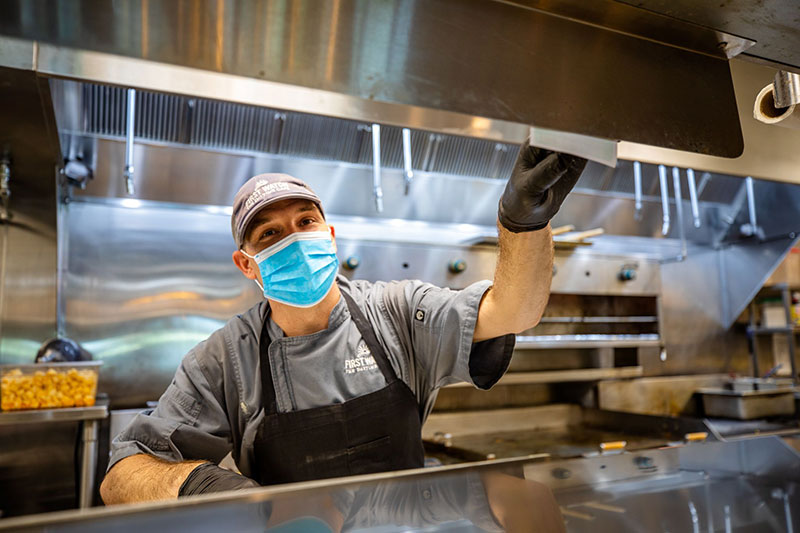The herd says the breakfast daypart has been one of the biggest losers during the pandemic, as working from home, job losses and a general reshaping of daily habits caused more people to either skip breakfast or eat something quick at home. Florida-based First Watch, a decades-old breakfast brand, says the herd mentality is wrong about breakfast: our upended world has resulted in more occasions and ways to experience breakfast, whether it’s a bowl of cereal at 2 a.m. or avocado toast for dinner.
While some restaurants have trimmed their breakfast menus or shifted their focus to lunch and dinner, First Watch, with more than 40 locations, is bucking the trends with only a slight overall sales decline compared to the previous year. CEO Chris Tomasso recently told Forbes they are seeing revenue come in at 90 percent of last year’s numbers, but with dining rooms only at 50 percent capacity.

Matt Eisenacher
Matt Eisenacher, First Watch’s senior vice president of brand strategy and innovation, said his previous years in the fast-casual space have proven helpful as he and the leadership team have worked at warp speed to roll out new processes and opportunities for customers to eat breakfast whenever they want.
“Understanding the dynamics of fast casual obviously has come to be pretty critical during COVID where peoples’ fundamental reasons and need states have just completely changed, so that’s probably the biggest element that has come to roost over the last few months,” he said. For me personally, that’s making sure that you don’t move too abruptly and make knee-jerk decisions based on what you might read one day or one week.”
While trying to avoid overly sudden moves, Eisenacher said he’s amazed at his team’s ability to move so quickly, especially for a brand that hasn’t strongly relied on third-party delivery or customer takeout before the pandemic.
Referencing his CEO’s handful of interviews commenting on the narrative of a breakfast daypart slowdown, Eisenacher stressed that he and his fellow C-suiters “just aren’t seeing” the headwinds some other brands have reported from the battlefield.
“Now that we have these channels that are now allowing people to eat in different ways, it’s frankly increased the number of occasions that you can enjoy the breakfast day part,” he said. Adding alcohol to approximately 150 of its stores has been part of that recipe.
Like many multi-unit brands, First Watch has rolled out digital menus, multiple delivery streams and a robust customer pickup channel, all while continuing to open new restaurants with no slowdown in sight. Also contrary to trends, First Watch has resisted the urge to trim its menus, while trying to differentiate its native and third-party ordering channels. Its current strategy includes reserving popular seasonal items for customers who order directly through the brand’s channels.
Investing in better in packaging has been a big “investment point” at the company, including adding see-through packages that reduce the chance of human errors, without having to open up the lid and let out heat and/or steam that is key to the appeal of so many breakfast items.
Looking ahead, the company is also developing its next generation restaurant template, with a primary goal of separating takeout customers from those dining inside the restaurant or waiting inside for a table. Eisenacher also said the team is weighing the pros and cons of adding a second make line to bring that same type of separation back into its kitchens.
“That conflict is the thing that can really sink businesses,” he added. “It’s the details of how you set your people up for your success, how do you staff for those new sales channels, how do you make sure you’re allowing customers to get it in a way that is increasing accuracy, and get it faster and allow them to grab it and go—all of these things need to be thought of in how we’re going to build the new group of First Watch restaurants.”
Before any shovels touch the dirt, in terms of the new-design locations, the company is also working on ways to communicate with off-premises guests in real time, whether that’s about substitutions, basic questions or issues related to food allergies. That functionality brings countless changes into the restaurant, with new screens and staff placement to ensure everything flows smoothly, rather than something less desirable only meant for the short term.
With native delivery up and running as of a few weeks ago, First Watch now has customers at all its restaurants ordering through its app and website, with the company reporting “extremely strong growth” on a daily and weekly basis. As a running change, it lowered the delivery fee for customers using native channels, and said these details are strategically one of its highest priorities going forward.
“Obviously if you’re waiting for a table you’re waiting outside now, and so if you are seeing 10 to 20 bags going out the front door, that balance is really important to us,” he added. “We are going through each restaurant that is doing a great job and finding best practices to make sure we optimize that balance of dine-in and off-premises traffic.”


